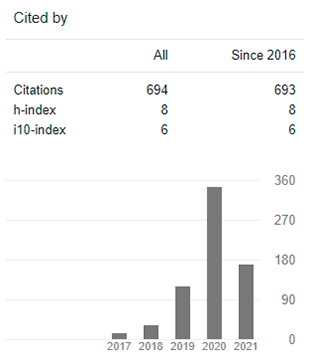Effect of conscious breathing on the attention task in adults
DOI:
https://doi.org/10.29394/Scientific.issn.2542-2987.2021.6.19.20.383-401Keywords:
attention, breathing, meditation, memory, learning, agingAbstract
This essay aims to review the publications associated with the attention task in adults by virtue of the impact of conscious breathing. The breathing techniques in the different styles of meditation have become relevant when evaluating the teaching-learning process in children, mainly in some higher cognitive functions such as inhibitory control. In adults, there is diffuse, unsystematized information on how these practices could impact the teaching-learning process, considering that adults present suppression of neurogenesis and neuroprotection, which leads to pathological alterations in mood, attention, memory and learning, as described by Innes and Selfe (2014). The evidence determines that it is feasible to generate an intervention to improve the learning environment, based on the impact it produces on attentional processes. This impact could determine the adequacy of public policies or interventions of public or private institutions, in order to enhance learning in adults and limit their cognitive deterioration, through the stimulation of their cognitive functions produced by conscious breathing.
Downloads
References
Abraham, W., & Richter-Levin, G. (2018). From Synaptic Metaplasticity to Behavioral Metaplasticity. Neurobiology of Learning and Memory, 154, 1-4, e-ISSN: 1074-7427. Retrieved from: https://doi.org/10.1016/j.nlm.2018.08.015
Ayalon, L., Shiovitz-Ezra, S., & Roziner, I. (2016). A cross-lagged model of the reciprocal associations of loneliness and memory functioning. Psychology and Aging, 31(3), 255-261, e-ISSN: 1939-1498. Retrieved from: https://doi.org/10.1037/pag0000075
Baez, M., Cercato, M., & Jerusalinsky, D. (2018). NMDA Receptor Subunits Change after Synaptic Plasticity Induction and Learning and Memory Acquisition. Neural Plasticity, 1-11, e-ISSN: 2090-5904. Retrieved from: https://doi.org/10.1155/2018/5093048
Bergman, E., de Bruin, A., Vorstenbosch, M., Kooloos, J., Puts, G., Leppink, J., … van der Vleuten, C. (2015). Effects of learning content in context on knowledge acquisition and recall: a pretest-posttest control group design. BMC Medical Education 15(133), 1-11, e-ISSN: 1472-6920. Retrieved from: https://doi.org/10.1186/s12909-015-0416-0
Bennett, D., Schneider, J., Arvanitakis, Z., Kelly, J., Aggarwal, N., & Wilson, R. (2006). Neuropathology of older persons without cognitive impairment from two community-based studies. Neurology, 66(12), 1837-1844, e-ISSN: 1526-632X. Retrieved from: https://doi.org/10.1212/01.wnl.0000219668.47116.e6
Bird, C., & Burgess, N. (2008a,b). The hippocampus and memory: insights from spatial processing. Nature Reviews Neuroscience, 9(3), 182-194, e-ISSN: 1471-0048. Retrieved from: https://doi.org/10.1038/nrn2335
Brefczynski-Lewis, J., Lutz, A., Schaefer, H., Levinson, D., & Davidson, R. (2007). Neural correlates of attentional expertise in long-term meditation practitioners. PNAS: Proceedings of the National Academy of Sciences, 104(27), 11483-11488, e-ISSN: 0027-8424. Retrieved from: https://doi.org/10.1073/pnas.0606552104
Chan, R., Immink, M., & Lushington, K. (2017). The influence of focused-attention meditation states on the cognitive control of sequence learning. Consciousness and Cognition, 55, 11-25, e-ISSN: 1053-8100. Retrieved from: https://doi.org/10.1016/j.concog.2017.07.004
Crestani, A., Krueger, J., Barragan, E., Nakazawa, Y., Nemes, S., Quillfeldt, J., … & Wiltgen, B. (2019a,b). Metaplasticity contributes to memory formation in the hippocampus. Neuropsychopharmacology, 44, 408-414. Retrieved from: https://doi.org/10.1038/s41386-018-0096-7
Crosson, B., Hampstead, B., Krishnamurthy, L., Krishnamurthy, V., McGregor, K., Nocera, J., ... Tran, S. (2017). Advances in neurocognitive rehabilitation research from 1992 to 2017: The ascension of neural plasticity. Neuropsychology, 31(8), 900-920, e-ISSN: 1931-1559. Retrieved from: https://doi.org/10.1037/neu0000396
Dahl, C., & Davidson, R. (2019). Mindfulness and the contemplative life: pathways to connection, insight, and purpose. Current Opinion in Psychology, 28, 60-64, e-ISSN: 2352-250X. Retrieved from: https://doi.org/10.1016/j.copsyc.2018.11.007
Ding, X., Maudsley, A., Sabati, M., Sheriff, S., Schmitz, B., Schütze, M., ... Lanfermann, H. (2016). Physiological neuronal decline in healthy aging human brain - An in vivo study with MRI and short echo-time whole-brain 1H MR spectroscopic imaging. NeuroImage, 137, 45-51, e-ISSN: 1053-8119. Retrieved from: https://doi.org/10.1016/j.neuroimage.2016.05.014
Farashahi, S., Donahue, C., Khorsand, P., Seo, H., Lee, D., & Soltani, A. (2017a,b). Metaplasticity as a Neural Substrate for Adaptive Learning and Choice under Uncertainty. Neuron, 94(2), 401-414, e-ISSN: 0896-6273. Retrieved from: https://doi.org/10.1016/j.neuron.2017.03.044
Fingelkurts, A., Fingelkurts, A., & Kallio-Tamminen, T. (2015). EEG-guided meditation: A personalized approach. Journal of Physiology-Paris, 109(4-6), 180-190, e-ISSN: 0928-4257. Retrieved from: https://doi.org/10.1016/j.jphysparis.2015.03.001
Gallant, S. (2016). Mindfulness meditation practice and executive functioning: Breaking down the benefit. Consciousness and Cognition, 40, 116-130, e-ISSN: 1053-8100. Retrieved from: https://doi.org/10.1016/j.concog.2016.01.005
Hölzel, B., Carmody, J., Vangel, M., Congleton, C., Yerramsetti, S., Gard, T., & Lazar, S. (2011). Mindfulness practice leads to increases in regional brain gray matter density. Psychiatry Research: Neuroimaging, 191(1), 36-43, e-ISSN: 0925-4927. Retrieved from: https://dx.doi.org/10.1016%2Fj.pscychresns.2010.08.006
Innes, K., & Selfe, T. (2014). Meditation as a therapeutic intervention for adults at risk for Alzheimer’s disease – potential benefits and underlying mechanisms. Frontiers in Psychiatry, 5(40), 1-9, e-ISSN: 1664-0640. Retrieved from: https://doi.org/10.3389/fpsyt.2014.00040
Kozhevnikov, M., Louchakova, O., Josipovic, Z., & Motes, M. (2009). The Enhancement of Visuospatial Processing Efficiency Through Buddhist Deity Meditation. Psychological Science, 20(5), 645-653, e-ISSN: 1467-9280. Retrieved from: https://doi.org/10.1111/j.1467-9280.2009.02345.x
Külz, A., Landmann, S., Cludius, B., Rose, N., Heidenreich, T., Jelinek, L., … Moritz, S. (2019). Mindfulness-based cognitive therapy (MBCT) in patients with obsessive-compulsive disorder (OCD) and residual symptoms after cognitive behavioral therapy (CBT): a randomized controlled trial. European Archives of Psychiatry and Clinical Neuroscience, 269(2), 223-233, e-ISSN: 1433-8491. Retrieved from: https://doi.org/10.1007/s00406-018-0957-4
Lerchenfeldt, S., Ferrari, T., Nyland, R., & Patino, G. (2016). Autonomic Nervous System Team-Based Learning Module. MedEdPORTAL: The Journal of Teaching and Learning Resources, 12, 1-10, e-ISSN: 2374-8265. Retrieved from: https://doi.org/10.15766/mep_2374-8265.10507
Lövdén, M., Schaefer, S., Pohlmeyer, A., & Lindenberger, U. (2008). Walking Variability and Working-Memory Load in Aging: A Dual-Process Account Relating Cognitive Control to Motor Control Performance. The Journals of Gerontology: Series B, 63(3), 121-128, e-ISSN: 1079-5014. Retrieved from: https://doi.org/10.1093/geronb/63.3.p121
Lutz, A., Slagter, H., Dunne, J., & Davidson, R. (2008a,b,c,d). Attention regulation and monitoring in meditation. Trends in Cognitive Sciences, 12(4), 163-169, e-ISSN: 1364-6613. Retrieved from: https://doi.org/10.1016/j.tics.2008.01.005
Manuello, J., Vercelli, U., Nani, A., Costa, T., & Cauda, F. (2016a,b,c). Mindfulness meditation and consciousness: An integrative neuroscientific perspective. Consciousness and Cognition, 40, 67-78, e-ISSN: 1053-8100. Retrieved from: https://doi.org/10.1016/j.concog.2015.12.005
Molnár, Z., Clowry, G., Šestan, N., Alzu'bi, A., Bakken, T., Hevner; R., … Kriegstein, A. (2019). New insights into the development of the human cerebral cortex. Journal of Anatomy, 235(3), 432-451, e-ISSN: 0021-8782. Retrieved from: https://doi.org/10.1111/joa.13055
Moore, A., Gruber, T., Derose, J., & Malinowski, P. (2012). Regular, brief mindfulness meditation practice improves electrophysiological markers of attentional control. Frontiers in Human Neuroscience, 6, 1-15, e-ISSN: 1662-5161. Retrieved from: https://doi.org/10.3389/fnhum.2012.00018
Newberg, A., Wintering, N., Khalsa, D., Roggenkamp, H., & Waldman, M. (2010). Meditation Effects on Cognitive Function and Cerebral Blood Flow In Subjects with Memory Loss: A Preliminary Study. Journal of Alzheimer's Disease, 20(2), 517-526, e-ISSN: 1875-8908. Retrieved from: https://doi.org/10.3233/JAD-2010-1391
Nielsen, L., & Kaszniak, A. (2006). Awareness of subtle emotional feelings: a comparison of long-term meditators and nonmeditators. Emotion, 6(3), 392-405, e-ISSN: 1931-1516. Retrieved from: https://doi.org/10.1037/1528-3542.6.3.392
O’Shea, R. (2017). Adult Neuroplasticity: Working One Eye Gives an Advantage to the Other. Current Biology, 27(6), 230-231, e-ISSN: 0960-9822. Retrieved from: https://doi.org/10.1016/j.cub.2017.02.021
Prätzlich, M., Kossowsky, J., Gaab, J., & Krummenacher, P. (2016). Impact of short-term meditation and expectation on executive brain functions. Behavioural Brain Research SreeTestContent1, 297, 268-276, e-ISSN: 0166-4328. Retrieved from: https://doi.org/10.1016/j.bbr.2015.10.012
Raykov, T., Baltes, M., Neher, K., & Sowarka, D. (2002). A comparative study of two psychometric approaches to detect risk status for dementia. Gerontology, 48(3), 185-193, e-ISSN: 1423-0003. Retrieved from: https://doi.org/10.1159/000052840
Rodríguez, M., García, W., & Fuentes, C. (2020). Valores éticos y emociones desde el desarrollo de metodologías activas en la formación docente. Revista Scientific, 5(15), 229-246, e-ISSN: 2542-2987. Recuperado de: https://doi.org/10.29394/Scientific.issn.2542-2987.2020.5.15.11.229-246
Rosenkranz, M., Lutz, A., Perlman, D., Bachhuber, D., Schuyler, B., MacCoon, D., & Davidson, R. (2016). Reduced stress and inflammatory responsiveness in experienced meditators compared to a matched healthy control group. Psychoneuroendocrinology, 68, 117-125 e-ISSN: 0306-4530. Retrieved from: https://doi.org/10.1016/j.psyneuen.2016.02.013
Salthouse, T. (2009). When does age-related cognitive decline begin?. Neurobiology of Aging, 30(4), 507-514, e-ISSN: 0197-4580. Retrieved from: https://doi.org/10.1016/j.neurobiolaging.2008.09.023
Slagter, H.., Davidson, R., & Lutz, A. (2011a,b). Mental training as a tool in the neuroscientific study of brain and cognitive plasticity. Frontiers in Human Neuroscience, 5, 1-12, e-ISSN: 1662-5161. Retrieved from: https://doi.org/10.3389/fnhum.2011.00017
Tomasino, B., Chiesa, A., & Fabbro, F. (2014). Disentangling the neural mechanisms involved in Hinduism- and Buddhism-related meditations. Brain and Cognition, 90, 32-40, e-ISSN: 0278-2626. Retrieved from: https://doi.org/10.1016/j.bandc.2014.03.013
Tsukiura, T., Fujii, T., Okuda, J., Ohtake, H., Kawashima, R., Itoh, M., … Yamadori, A. (2002). Time-dependent contribution of the hippocampal complex when remembering the past: a PET study. NeuroReport: For Rapid Communication of Neuroscience Research, 13(17), 2319–2323. Retrieved from: https://doi.org/10.1097/00001756-200212030-00030
Turakitwanakan, W., Pongpaplud, P., & Kitporntheranunt, M. (2016). The Effect of Home Buddhist Mindfulness Meditation on Depressive Symptom in Major Depressive Patients. Journal of the Medical Association of Thailand, 99(11), 171-178, ISSN: 0125-2208. Thailand: Medical Association of Thailand.
Vartak, D., Jeurissen, D., Self, M., & Roelfsema, P. (2017). The influence of attention and reward on the learning of stimulus-response associations. Scientific Reports, 7, 1-12, e-ISSN: 2045-2322. Retrieved from: https://doi.org/10.1038/s41598-017-08200-w
Wang, V., & Storey, V. (2015). Andragogy and Teaching English as a Foreign Language in China. The Reference Librarian, 56(4), 295-314, e-ISSN: 0276-3877. Retrieved from: https://doi.org/10.1080/02763877.2015.1057680
Watts, K. (2018). Tools and Principles for Effective Online Library Instruction: Andragogy and Undergraduates. Journal of Library & Information Services in Distance Learning, 12(1-2), 49-55, e-ISSN: 1533-290X. Retrieved from: https://doi.org/10.1080/1533290X.2018.1428712
Wielgosz, J., Goldberg, S., Kral, T., Dunne, J., & Davidson, R. (2019). Mindfulness Meditation and Psychopathology. Annual Review of Clinical Psychology, 15, 285-316, e-ISSN: 1548-5943. Retrieved from: https://doi.org/10.1146/annurev-clinpsy-021815-093423
Youde, A. (2018a,b). Andragogy in blended learning contexts: effective tutoring of adult learners studying part-time, vocationally relevant degrees at a distance. International Journal of Lifelong Education, 37(2), 255-272, e-ISSN: 0260-1370. Retrieved from: https://doi.org/10.1080/02601370.2018.1450303
Young, J., & Taylor, E. (1998a,b). Meditation as a Voluntary Hypometabolic State of Biological Estivation. Physiology, 13(3), 149-153, e-ISSN: 1548-9213. Retrieved from: https://doi.org/10.1152/physiologyonline.1998.13.3.149
Zeithamova, D., Dominick, A., & Preston, A. (2012). Hippocampal and Ventral Medial Prefrontal Activation during Retrieval-Mediated Learning Supports Novel Inference. Neuron, 75(1), 168-179, e-ISSN: 0896-6273. Retrieved from: https://doi.org/10.1016/j.neuron.2012.05.010
Downloads
Published
How to Cite
Issue
Section
License
The content of the journals of this site, are under a Creative Commons Attribution-Noncommercial-Share Alike 4.0 International License.













